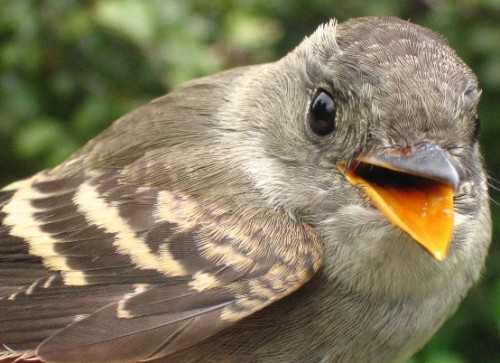|
McGILL BIRD OBSERVATORY |
|||||||||||||||||||||||||||||||||||||||||||||||||||||||||||||||||||||
Welcome
to the McGill Bird Observatory weekly report.
Click here for a complete listing of our archives.
Bander-in-charge:
Seabrooke Leckie Notes: Week 5 has been our slowest week thus far this season, with just 147 birds banded during the seven day period despite consistent north winds. Certainly the totals from the last day of the previous update period remain unmatched, and most days this week fewer than 30 birds were banded. Good conditions overnight encouraged the birds from last Monday to move on, and while a few warbler flocks were encountered on Tuesday, the count area was relatively quiet. However, an Olive-sided Flycatcher spotted on census provided a nice highlight. Our most interesting captures for the 29th came in the form of non-bird life: a bat was caught in the half-light of opening round, and a Gray Treefrog was discovered in one of the nets later in the morning. Numbers continued to decrease on Wednesday, with steady but low activity in the nets all morning. Several small groups of warblers were observed moving through the area, though they successfully evaded capture. Among the flocks were three Northern Parulas, a Philadelphia Vireo and a high count of 16 Common Yellowthroats. The first Lincoln's Sparrow of the season was captured among the flocks of warblers. Despite ideal weather conditions overnight, Thursday and Friday were both very quiet days, with just 22 birds banded between them. However, both days afforded some excellent birding, and in fact Thursday produced our highest one-day species total for the fall so far, with 57 species tallied. Highlights among these included Scarlet Tanager, Cape May Warbler, a lateish Purple Martin, and a low-flying Broad-winged Hawk. A noticable influx of White-throated Sparrows was present on the 31st, and Song Sparrow and American Goldfinch numbers were also quite high. On the first day of September we were treated to the spectacle of about 300 Common Grackles swirling and circling above the lab, and landing in the trees and bushes just to the west. Fortunately most of them managed to avoid the nets, but we did band two females from the flock. Activity picked up a bit for the 2nd as several flocks of warblers were observed in the count area. A small group of them were captured early which included Blackburnian, Bay-breasted, Blackpoll and Mourning Warblers. Hawks were prominent in the area with several accipiters as well as a Northern Harrier and the local Red-shouldered Hawk spotted, most while they were being harried by vigilent crows. The Common Grackles seem to have formed a roost somewhere to the north, as another 550 flew over in a narrow stream early in the morning. Sunday was wet and rainy, resulting in no net hours and very little observation time. Census was completed by an intrepid and well-prepared volunteer. Little of note was observed, and the species total of 18 was even lower than last week's rainy day. However, once again activity rebounded the following day, and while not quite as busy as last Monday, a total of 45 birds were captured on the fourth. A few mixed flocks were captured as they moved through, including Bay-breasted, Black-throated Blue and several Wilson's Warblers as well as a Philadelphia Vireo and the season's first Swainson's Thrush and Eastern Wood-pewee captured. The most interesting observation on the day was a Virginia Rail calling from the cattails at the north end of Stoneycroft Pond, as this isn't a common species for MBO, especially in the fall. We seem to have reached the September lull a week early this year - if we're lucky, that should mean that the mid-September warbler push is just around the corner!
Consistent with it being a quiet week for migration, there wasn't much change in the top 10 lists compared to last week. White-throated Sparrows are being seen increasingly, and it's likely they'll remain among the most abundant birds for the remainder of the fall. A fair number of Red-eyed Vireos were banded this week for the first time this fall, a noticeable contrast to 2005 when nearly 100 had been banded by this point in the season. The Common Grackles are now far out in front of all other species as the most abundant bird on site, and this may last for a while too, as the flock seems to have settled in as it did for several weeks last fall.
|


